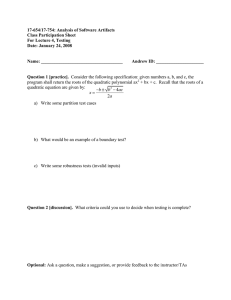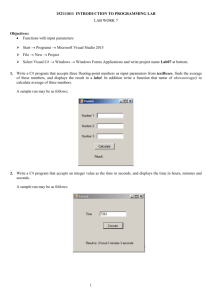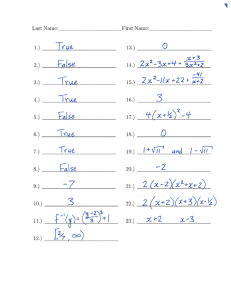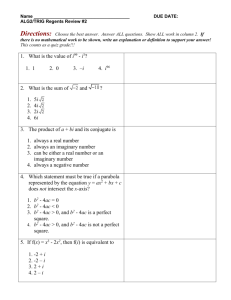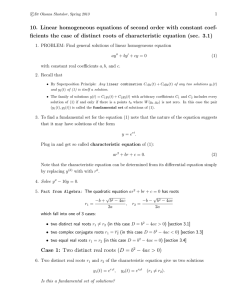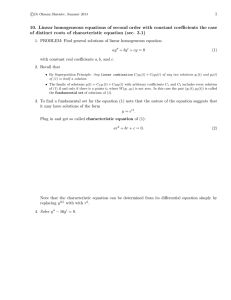Lecture 4 Natural response of first and second order systems
advertisement
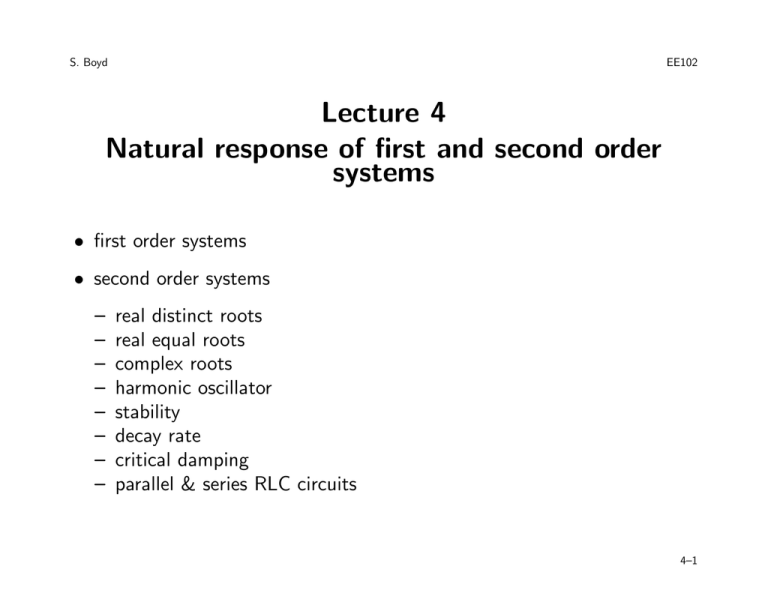
S. Boyd
EE102
Lecture 4
Natural response of first and second order
systems
• first order systems
• second order systems
–
–
–
–
–
–
–
–
real distinct roots
real equal roots
complex roots
harmonic oscillator
stability
decay rate
critical damping
parallel & series RLC circuits
4–1
First order systems
ay 0 + by = 0
(with a 6= 0)
righthand side is zero:
• called autonomous system
• solution is called natural or unforced response
can be expressed as
T y0 + y = 0
or
y 0 + ry = 0
where
• T = a/b is a time (units: seconds)
• r = b/a = 1/T is a rate (units: 1/sec)
Natural response of first and second order systems
4–2
Solution by Laplace transform
take Laplace transform of T y 0 + y = 0 to get
T (sY (s) − y(0)) + Y (s) = 0
{z
}
|
L(y 0 )
solve for Y (s) (algebra!)
y(0)
T y(0)
=
Y (s) =
sT + 1 s + 1/T
and so y(t) = y(0)e−t/T
Natural response of first and second order systems
4–3
solution of T y 0 + y = 0: y(t) = y(0)e−t/T
if T > 0, y decays exponentially
• T gives time to decay by e−1 ≈ 0.37
• 0.693T gives time to decay by half (0.693 = log 2)
• 4.6T gives time to decay by 0.01 (4.6 = log 100)
if T < 0, y grows exponentially
• |T | gives time to grow by e ≈ 2.72;
• 0.693|T | gives time to double
• 4.6|T | gives time to grow by 100
Natural response of first and second order systems
4–4
Examples
simple RC circuit:
ag replacements
R
circuit equation: RCv 0 +v = 0
C
v
solution: v(t) = v(0)e−t/(RC)
population dynamics:
• y(t) is population of some bacteria at time t
• growth (or decay if negative) rate is y 0 = by − dy where b is birth rate,
d is death rate
• y(t) = y(0)e(b−d)t (grows if b > d; decays if b < d)
Natural response of first and second order systems
4–5
thermal system:
• y(t) is temperature of a body (above ambient) at t
• heat loss proportional to temp (above ambient): ay
• heat in body is cy, where c is thermal capacity, so cy 0 = −ay
• y(t) = y(0)e−at/c; c/a is thermal time constant
Natural response of first and second order systems
4–6
Second order systems
ay 00 + by 0 + cy = 0
assume a > 0 (otherwise multiply equation by −1)
solution by Laplace transform:
a(s2Y (s) − sy(0) − y 0(0)) + b(sY (s) − y(0)) + cY (s) = 0
{z
}
{z
}
|
|
L(y 00 )
L(y 0 )
solve for Y (just algebra!)
αs + β
asy(0) + ay 0(0) + by(0)
= 2
Y (s) =
as2 + bs + c
as + bs + c
where α = ay(0) and β = ay 0(0) + by(0)
Natural response of first and second order systems
4–7
so solution of ay 00 + by 0 + cy = 0 is
y(t) = L−1
µ
αs + β
as2 + bs + c
¶
• χ(s) = as2 + bs + c is called characteristic polynomial of the system
• form of y = L−1(Y ) depends on roots of characteristic polynomial χ
• coefficients of numerator αs + β come from initial conditions
Natural response of first and second order systems
4–8
Roots of χ
(two) roots of characteristic polynomial χ are
λ1,2
√
−b ± b2 − 4ac
=
2a
i.e., we have as2 + bs + c = a(s − λ1)(s − λ2)
three cases:
• roots are real and distinct: b2 > 4ac
√
√
2
−b + b − 4ac
−b − b2 − 4ac
, λ2 =
λ1 =
2a
2a
• roots are real and equal: b2 = 4ac
λ1 = λ2 = −b/(2a)
Natural response of first and second order systems
4–9
• roots are complex (and conjugates): b2 < 4ac
λ1 = σ + jω,
λ2 = σ − jω,
where σ = −b/(2a) and
√
4ac − b2 p
= (c/a) − (b/2a)2
ω=
2a
Natural response of first and second order systems
4–10
Real distinct roots (b2 > 4ac)
χ(s) = a(s − λ1)(s − λ2) (λ1, λ2 real)
from page 4-6,
αs + β
Y (s) =
a(s − λ1)(s − λ2)
where α, β depend on initial conditions
express Y as
Y (s) =
where r1 and r2 are found from
r1 + r2 = α/a,
which yields
r2
r1
+
s − λ1 s − λ2
−λ2r1 − λ1r2 = β/a
λ1 α + β
,
r1 = √
2
b − 4ac
Natural response of first and second order systems
−λ2α − β
r2 = √
b2 − 4ac
4–11
now we can find the inverse Laplace tranform . . .
y(t) = r1eλ1t + r2eλ2t
a sum of two (real) exponentials
• coefficients of exponentials, i.e., λ1, λ2, depend only on a, b, c
• associated time constants T1 = 1/|λ1|, T2 = 1/|λ2|
• r1, r2 depend (linearly) on the initial conditions y(0), y 0(0)
• signs of λ1, λ2 determine whether solution grows or decays as t → ∞
• magnitudes of λ1, λ2 determine growth rate (if positive) or decay rate
(if negative)
Natural response of first and second order systems
4–12
PSfrag replacements
Example: second-order RC circuit
1Ω
t=0
1F
1Ω
1F
y
at t = 0, the voltage across each capacitor is 1V
• for t ≥ 0, y satisfies LCCODE (from page 2-18)
y 00 + 3y 0 + y = 0
• initial conditions:
y(0) = 1,
y 0(0) = 0
(at t = 0, voltage across righthand capacitor is one; current through
righthand resistor is zero)
Natural response of first and second order systems
4–13
solution using Laplace transform
• characteristic polynomial: χ(s) = s2 + 3s + 1
• b2 = 9 > 4ac = 4, so roots are real & distinct: λ1 = −2.62, λ2 = −0.38
• hence, solution has form
y(t) = r1e−2.62 t + r2e−0.38 t
• initial conditions determine r1, r2:
y(0) = r1 + r2 = 1,
y 0(0) = −2.62r1 − 0.38r2 = 0
yields r1 = −0.17, r2 = 1.17,
y(t) = −0.17e−2.62 t + 1.17e−0.38 t
Natural response of first and second order systems
4–14
• first exponential decays fast, within 2sec (T1 = 1/|λ1| = 0.38)
• second exponential decays slower (T2 = 1/|λ2| = 2.62)
expanded scale, for 0 ≤ t ≤ 2
1
0.8
0.9
0.6
0.8
y
y
1
placements
0.7
0.4
0.2
0
0
PSfrag replacements
5
10
15
t
Natural response of first and second order systems
20
0.6
0.5
0
0.5
1
1.5
2
t
4–15
Real equal roots (b2 = 4ac)
χ(s) = a(s − λ)2
from page 4-6,
with λ = −b/(2a)
αs + β
Y (s) =
a(s − λ)2
express Y as
Y (s) =
r2
r1
+
s − λ (s − λ)2
where r1 and r2 are found from r1 = α/a, −λr1 + r2 = β/a, which yields
r1 = α/a,
r2 = (β + λα)/a
inverse Laplace transform is
y(t) = r1eλt + r2teλt
Natural response of first and second order systems
4–16
Example: mass-spring-damper
y
m
PSfrag replacements
k
b
mass m = 1, stiffness k = 1, damping b = 2
• LCCODE (from page 2-19):
y 00 + 2y 0 + y = 0
• initial conditions
y(0) = 0,
Natural response of first and second order systems
y 0(0) = 1
4–17
solution using Laplace transform
• characteristic polynomial: s2 + 2s + 1 = (s + 1)2
• solution has form y(t) = r1e−t + r2te−t
• initial conditions determine r1, r2: y(0) = r1 = 0, y 0(0) = −r1 + r2 = 1
yields r1 = 0, r2 = 1, i.e.,
y(t) = te−t
0.4
0.35
0.3
y
0.25
0.2
0.15
PSfrag replacements
0.1
0.05
0
0
2
4
6
8
10
t
called critically damped system (more later)
Natural response of first and second order systems
4–18
Complex roots (b2 < 4ac)
χ(s) = a(s − λ)(s − λ) with λ = σ + jω, λ = σ − jω
from page 4-6,
Y (s) =
express Y as
αs + β
a(s − λ)(s − λ)
r2
r1
+
Y (s) =
s−λ s−λ
where r1 and r2 follow from r1 + r2 = α/a, −r1λ − r2λ = β/a:
r1 =
αb − 2aβ
α
+j
,
2
2a
4a ω
r2 = r 1
inverse Laplace transform is
y(t) = r1eλt + r1eλt
Natural response of first and second order systems
4–19
other useful forms:
y(t) = r1eλt + r1eλt
= r1eσt(cos ωt + j sin ωt) + r 1eσt(cos ωt − j sin ωt)
= (<(r1) + j=(r1)) eσt(cos ωt + j sin ωt)
+ (<(r1) − j=(r1))eσt (cos ωt − j sin ωt)
= 2eσt (<(r1) cos ωt − =(r1) sin ωt)
= Aeσt cos(ωt + φ)
where A = 2|r1|, φ = arctan(=(r1)/<(r1))
• if σ > 0, y is an exponentially growing sinusoid; if σ < 0, y is an
exponentially decaying sinusoid; if σ = 0, y is a sinusoid
• <λ = σ gives exponential rate of decay or growth; =λ = ω gives
oscillation frequency
• amplitude A and phase φ determined by initial conditions
• Aeσt is called the envelope of y
Natural response of first and second order systems
4–20
example
1
y
0.5
0
−0.5
PSfrag replacements
−1
0
1
2
3
4
5
6
7
8
t
what are σ and ω here?
• oscillation period is 2π/ω
• envelope decays exponentially with time constant −1/σ
Natural response of first and second order systems
4–21
• envelope gives |y| when sinusoid term is ±1
• if σ < 0, envelope decays by 1/e in −1/σ seconds
• if σ > 0, envelope doubles every 0.693/σ seconds
• growth/decay per period is e2π(σ/ω)
• if σ < 0, number of cycles to decay to 1% is
(4.6/2π)(ω/|σ|) = 0.73(ω/|σ|)
Natural response of first and second order systems
4–22
The harmonic oscillator
system described by LCCODE
y 00 + ω 2y = 0
• characteristic polynomial is s2 + ω 2; roots are ±jω
• solutions are sinusoidal: y(t) = A cos(ωt + φ), where A and φ come
from initial conditions
LC circuit
• from i = Cv 0, v = −Li0 we get
PSfrag replacements
v 00 + (1/LC)v = 0
L
i
C
v
√
• oscillation frequency is ω = 1/ LC
Natural response of first and second order systems
4–23
mass-spring system
y
m
00
• my + ky = 0;
• oscillation frequency is ω
p
replacements
k/m
=PSfrag
Natural response of first and second order systems
k
4–24
Stability of second order system
second order system
ay 00 + by 0 + cy = 0
(recall assumption a > 0)
we say the system is stable if y(t) → 0 as t → ∞ no matter what the
initial conditions are
when is a 2nd order system stable?
• for real distinct roots, solutions have the form y(t) = r1eλ1t + r2eλ2t
for stability, we need
√
−b + b2 − 4ac
< 0,
λ1 =
2a
λ2 =
−b −
√
b2 − 4ac
< 0,
2a
we must have b > 0 and 4ac > 0, i.e., c > 0
Natural response of first and second order systems
4–25
• for real equal roots, solutions have the form y(t) = r1eλt + r2teλt
for stability, we need
λ = −b/2a < 0
i.e., b > 0; since b2 = 4ac, we also have c > 0
• for complex roots, solutions have the form y(t) = Aeσt cos(ωt + φ)
for stability, we need
σ = <λ = −b/2a < 0
i.e., b > 0; since b2 < 4ac we also have c > 0
summary: second order system with a > 0 is stable when
b > 0 and c > 0
Natural response of first and second order systems
4–26
Decay rate
assume system ay 00 + by 0 + cy = 0 is stable (a, b, c > 0); how fast do the
solutions decay?
• real distinct roots (b2 > 4ac)
since λ1 > λ2, for t large,
¯
¯
¯ λ t¯
¯r1 e 1 ¯ À ¯ r2 e λ 2 t ¯
(assuming r1 is nonzero); hence asymptotic decay rate is given by
−λ1 =
Natural response of first and second order systems
b−
√
b2 − 4ac
2a
4–27
• real equal roots (b2 = 4ac)
solution is r1eλt + r2teλt which decays like eλt, so decay rate is
−λ = b/(2a) =
p
c/a
• complex roots (b2 < 4ac)
solution is Aeσt cos(ωt + φ), so decay rate is
−σ = −<(λ) = b/(2a)
Natural response of first and second order systems
4–28
Critical damping
question: given a > 0 and c > 0, what value of b > 0 gives maximum
decay rate?
answer:
√
b = 2 ac
p
which corresponds to equal roots, and decay rate c/a
√
• b = 2 ac is called critically damped (real, equal roots)
√
• b > 2 ac is called overdamped (real, distinct roots)
√
• b < 2 ac is called underdamped (complex roots)
justification:
p
• if the system is underdamped, the decay rate is worse than c/a
because
p
b/(2a) < c/a,
√
if b < 2 ac
Natural response of first and second order systems
4–29
p
• if the system is overdamped, the decay rate is worse than c/a because
b−
√
b2 − 4ac p
< c/a
2a
to prove this, multiply by 2a and re-arrange to get
√
p
b − 2 ac < b2 − 4ac
rewrite as
√
?
b − 2 ac <
√
divide by b − 2 ac to get
q
?
√
√
(b − 2 ac)(b + 2 ac)
p
√
?
b + 2 ac
1< p
√
b − ac
which is true . . .
Natural response of first and second order systems
4–30
Parallel RLC circuit
i
PSfrag replacements
L
R
C
v
we have v = −Li0 and Cv 0 = i − v/R, so
v 00 +
1 0
1
v +
v=0
RC
LC
• stable (assuming L, R, C > 0)
p
• overdamped if R < L/(4C)
p
• critically damped if R = L/(4C)
p
• underdamped if R > L/4C; oscillation frequency is
ω=
Natural response of first and second order systems
p
1/LC − (1/2RC)2
4–31
Series RLC circuit
PSfrag replacements
R
L
i
C
v
by KVL, Ri + Li0 + v = 0; also, i = Cv 0, so
R 0
1
v=0
v + v +
L
LC
00
• stable (assuming L, R, C > 0)
p
• overdamped if R > 2 L/C
p
• critically damped if R = 2 L/C
p
• underdamped if R < 2 L/C; oscillation frequency is
p
ω = 1/LC − (R/2L)2
Natural response of first and second order systems
4–32
